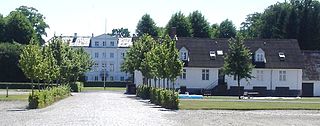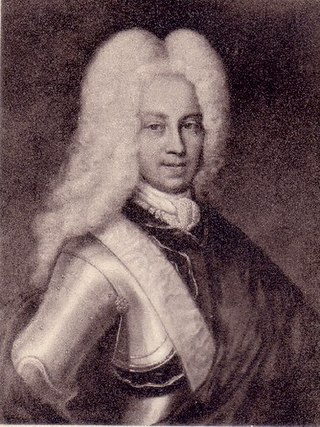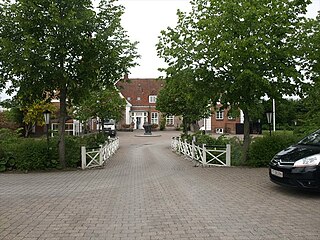Related Research Articles
The Diocese of Zealand was a Lutheran diocese in Denmark that existed from 1537 to 1922. The diocese had been formed in 1537 following the Reformation of Denmark, and was dissolved in 1922 when it was divided into the Diocese of Copenhagen and the Diocese of Roskilde. While it existed, the diocese functioned as the head of the Church of Denmark, beneath the crown, and its bishop was regarded as Primus inter pares.
Events from the year 1736 in Denmark.

Knuthenborg is a manor house located 6 km (3.7 mi) north of Maribo on the Danish island of Lolland. Originally known as Årsmarke, it was first mentioned in 1372. Today's building was completed in 1866 to a design by Henrik Steffens Sibbern. The medieval manor of Årsmarke, with its more than 300 years of history, was once Denmark's largest private estate; it is now part of Knuthenborg Safaripark. The exotic shrubs and trees planted during the era of the Counts of Knuthenborg are situated on the grounds.

Stokkemarke is a village on the Danish island of Lolland located midway between Nakskov and Maribo. In January 2024 it had a population of 416. Stokkemarke Church, first documented in 1396, originally built in the Romanesque style, has Gothic additions.

Hunseby is a village located some 3 km (1.9 mi) north of Maribo on the Danish island of Lolland. It belongs to Lolland Municipality in Region Sjælland. As of 2024, it has a population of 399.

Bonderup, also known as Bonderupgård, is a manor house located 16 kilometres (9.9 mi) south of Holbæk, Denmark. Nonderup and nearby Merløsegaard were purchased by the merchant Johannes Theodorus Suhr in 1852 and is now owned by the Suhr Family Trust. Bånderup and Merløse have a combined area of 1m310 hectares.
Ravnstrup is a manor house and estate situated north of Næstved, on the southern part of Zealand, Denmark.

Lilliendal is a manor house and estate located at Vordingborg in southeastern Denmark. The estate covers approximately 800 hectares of mostly farmland. Lilliendal was established by Hans Gustav Lillienskiold (1727–1796) in the 1760s and later owned by the Knuth family for almost two hundred years from the 1800s to 1994. A relatively small main building from 1765 was expanded in the 1850s and again in 1919.
Rosengaard is a manor house and estate in Ringsted Municipality, Denmark.
Espe is a manor house and estate located at Boeslunde, between Korsør and Skælskør, Slagelse Municipality, some 100 kilometres southwest of Copenhagen. Espe has been listed on the Danish registry of protected buildings and places since 1918. The main building dates to the 18th century but was adapted to the Late Neoclassical style in 1848. The manor and estate has been owned by members of the Moltke family since 1810.
Mørup is a manor house and estate located close to Sorø, Denmark. It is now owned by Sorø Academy The half-timbered main building dates from the beginning of the 19th century.

Adam Christopher (von) Knuth was the first Count of Knuthenborg. He established the manor of Knuthenlund. He was married twice, first to Hedevig Ulrikke Luxdorph and second time to Ida Margrethe von Reventlow.

Sørup is a manor house and estate located 6 kilometres south of Ringsted, Denmark. The current Historicist main building was constructed after a fire in 1909. It is now operated as a hotel and conference centre.

Fredsholm is a manor house and estate located close to Nakskov on the island of Lolland in southeastern Denmark. Fredsholm and Rudbjerggaard had the same owners in the period 1674–1819.

Frederiksdal is a manor house and estate located 10 km northwest of Nakskov on Lolland, in southeastern Denmark. The estate covers 538 hectares of land. It is known for its fortified cherry wine.

Valnæsgård, formerly Egensegaard, is a manor house and estate located on the northwestern tip of Falster, 20 km northwest of Nykøbing Falster in southeastern Denmark.

Lars Lassen was a Danish landowner, proprietor, chamber councilor "kammerråd" and agricultural commissioner. He was the son of Niels Lassen (1729-1811) and Karen Sørensdatter (1726-1810). Lassen owned the estates Benzonseje (Risbyholm), Rosengård, Adamshøj, Egholm, Krabbesholm and Meilgaard. He was married to Johanne Kirstine Meyer (1763-1846), who was the daughter of Procurator Peter Simonsen Meyer, and they had approximately 8 children together.
Events from the year 1687 in Denmark.

Frederik Christian Julius greve Knuth was a Danish landowner and county governor. He was the brother of Eggert Christopher Knuth and father of Adam Knuth.

Eggert Christopher (von) Knuth, Count of Knuthenborg and Gyldensteen was a Danish landowner, Supreme Court justice and Prefect of the Diocese of Zealand. He was the brother of Christian Frederik and Conrad Ditlev Knuth and the father of Johan Henrik Knuth and Frederik Knuth.
References
- ↑ "Ejerhistorie" (in Danish). danskeherregaarde.dk. Archived from the original on 11 October 2016. Retrieved 9 October 2016.
- 1 2 "Hun vil lave verdens bedste fødevarer". Berlingske. Retrieved 9 October 2016.
- ↑ "The Knuthenborg Cheese Awards". Knuthenborg. Retrieved 9 October 2016.